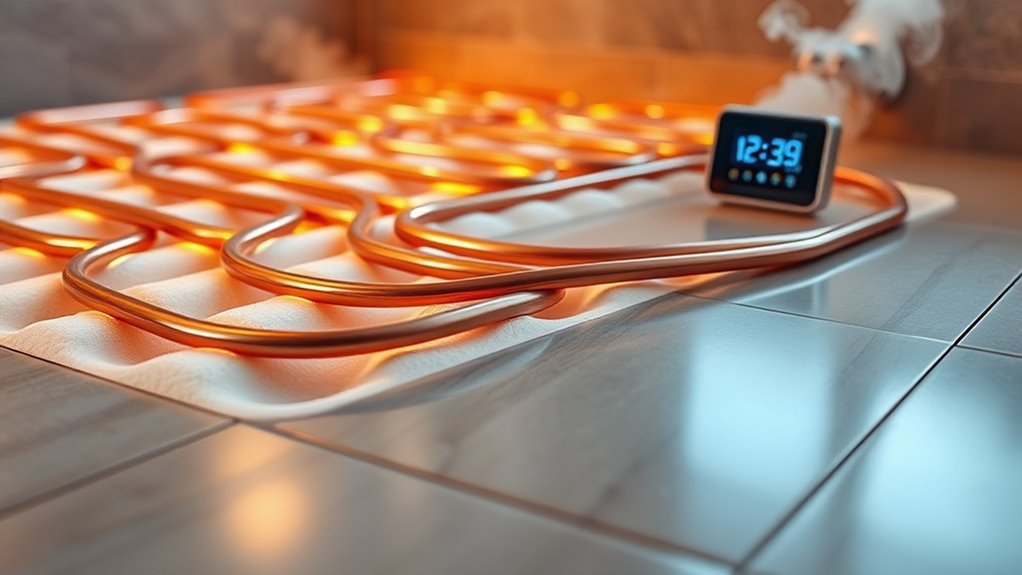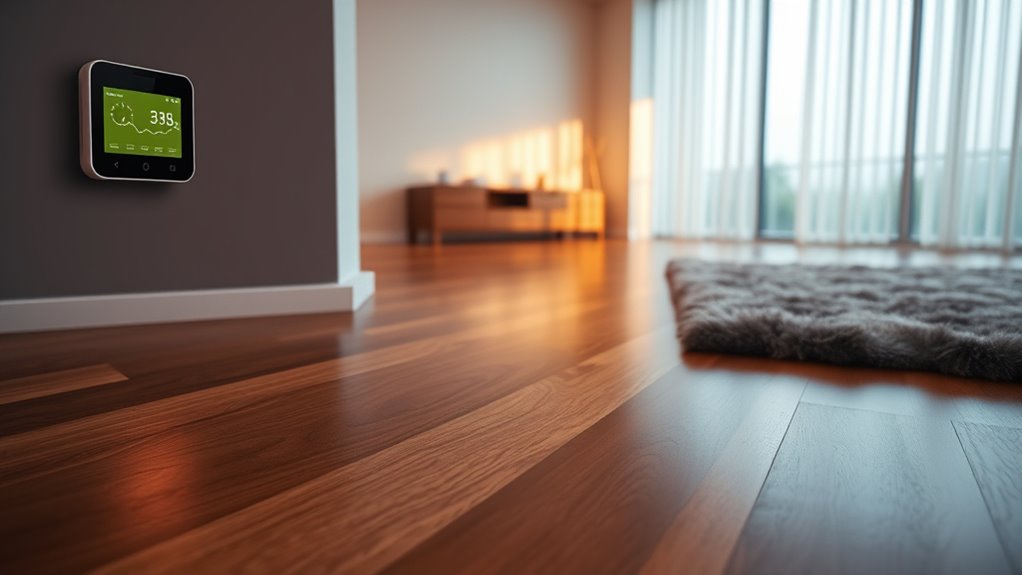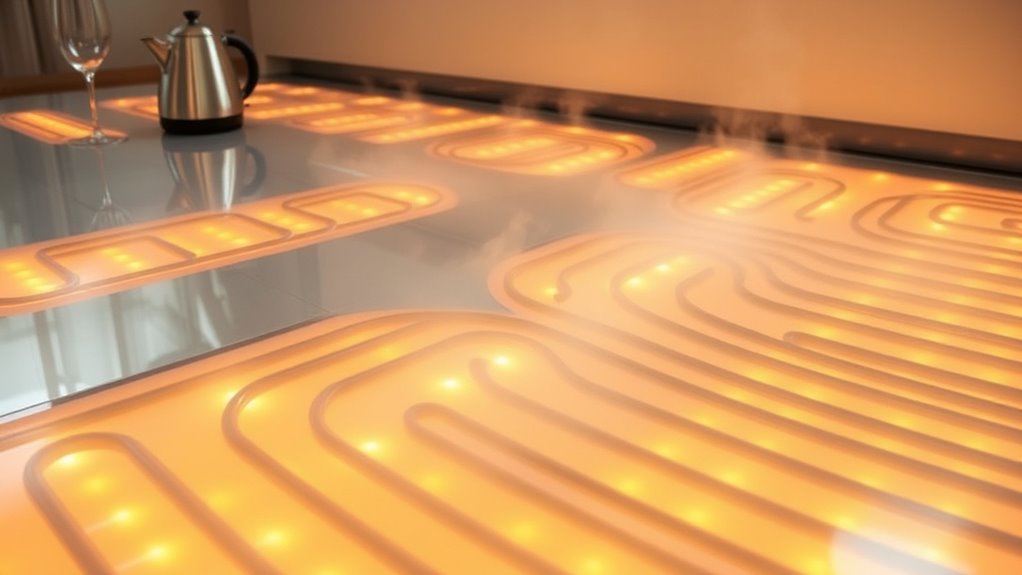Radiant floor heating works by transferring heat directly through your floor materials, warming objects and people via infrared radiation rather than just heating air. You’ll find two main types: electric systems using cables or mats, and hydronic systems circulating warm water through tubing. Key components include heat sources, insulation, and thermostats, ensuring efficient and consistent warmth. Installation can be wet or dry, impacting heat retention and repair access. Understanding these basics sets the stage to explore system specifics and benefits further.
The Science Behind Radiant Floor Heating

Although you might not see it, radiant floor heating relies on the principle of heat transfer through infrared radiation, which directly warms objects and people in a room rather than just heating the air. This process leverages thermal conductivity, where heat is efficiently transferred from the heated floor surface to your surroundings. The floor materials, typically with high thermal conductivity, guarantee rapid and even distribution of heat. As heat radiates upward, it creates a comfortable environment without convection currents that often cause uneven temperature zones. This method enhances energy efficiency and comfort freedom, allowing you to enjoy consistent warmth without relying on forced air systems. Understanding this science empowers you to appreciate how radiant floor heating offers a precise, effective thermal solution for your living space.
Types of Radiant Floor Heating Systems
There are two primary types of radiant floor heating systems you should consider: electric and hydronic. Electric systems use electric cables or mats beneath the floor to generate heat, offering straightforward installation and precise control, ideal for smaller areas. Hydronic systems circulate warm water through tubing embedded in the floor, providing efficient, cost-effective heating for larger spaces but requiring more complex installation.
| Functie | Electric Systems | Hydronische systemen |
|---|---|---|
| Heat Source | Electric cables/mats | Heated water circulation |
| Installatie | Easier, less invasive | Complex, involves plumbing |
| Best Use Case | Small rooms or spot heating | Whole-house or larger areas |
Choosing between these systems depends on your space size, budget, and installation preferences, empowering you to control comfort freely.
Components of a Radiant Floor Heating Setup

A radiant floor heating setup consists of several key components that work together to deliver consistent and efficient warmth. First, the heat sources—either electric cables or hydronic tubing—generate the necessary thermal energy. These elements are embedded beneath your floor surface. Next, insulation materials play an important role; they’re installed below or around the heat elements to minimize heat loss downward, ensuring maximum energy efficiency. A thermostat regulates the system, allowing you precise control over temperature settings for comfort and energy savings. Additionally, a manifold and pump system is essential in hydronic setups to distribute heated water evenly through the tubing. Together, these components create a reliable, efficient system that frees you from uneven heating and reduces energy waste.
Installation Methods for Radiant Floor Heating
When installing radiant floor heating, you’ll choose between two primary methods: wet and dry installations. Wet installations embed heating materials like PEX tubing directly into a concrete slab or a gypsum-based screed, providing excellent thermal mass for efficient heat distribution. This technique requires precise planning, as the slab acts both as a heat conductor and structural element. Dry installations, on the other hand, involve placing heating mats or panels over subflooring, then covering them with plywood or other vloeren materials. This method offers quicker installation and easier access for repairs but may deliver less consistent heat transfer. Understanding these installation techniques allows you to select the approach that fits your project’s structural constraints and desired performance, granting you freedom in design while ensuring peak operation of your radiant floor heating system.
Energy Efficiency and Cost Benefits

Choosing the right installation method impacts not only performance but also how efficiently your radiant floor heating system uses energy. By utilizing hydronic systems with precise temperature controls, you can maximize energy savings, reducing your heating bills considerably compared to traditional forced-air systems. A thorough cost analysis reveals that, although upfront installation costs might be higher, the long-term operational expenses are lower due to improved heat retention and minimal heat loss. Electric systems offer easier installation but typically have higher energy costs. Your freedom to customize system zoning further enhances efficiency by targeting heat exactly where and when you need it. Ultimately, understanding these factors empowers you to optimize both energy savings and cost efficiency, ensuring your radiant floor heating system aligns with your financial and comfort goals.
Common Applications and Ideal Spaces
Radiant floor heating excels in spaces where consistent, even warmth enhances comfort and efficiency. You’ll find it ideal for areas like bathrooms, where bathroom comfort is paramount, eliminating cold tile surfaces and providing soothing warmth underfoot. Similarly, it’s perfect for living rooms, delivering uniform living room warmth that traditional heating systems struggle to achieve. This method suits open floor plans and rooms with high ceilings by promoting upward heat distribution without drafts. You can also install it under various flooring types, including tile, stone, and engineered wood, maximizing flexibility in design. Whether retrofitting or building new, radiant floor heating offers you reliable, unobtrusive heat, freeing you from bulky radiators or vents and enabling precise temperature control tailored to your lifestyle.
Maintenance and Longevity Considerations
Although radiant floor heating systems are designed for durability, proper maintenance is essential to guarantee their ideal performance and extend their lifespan. You should schedule routine checks to inspect pipes, valves, and thermostats for wear or leaks. System upgrades, such as installing smart thermostats or improved insulation, can enhance efficiency and comfort. Addressing issues early prevents costly repairs and maintains consistent heat output.
| Maintenance Task | Frequentie | Doel |
|---|---|---|
| Inspect piping | Jaarlijks | Detect leaks or corrosion |
| Test thermostats | Semi-annually | Verify accurate temperature control |
| Flush system | Every 3-5 years | Remove sediment buildup |
| Upgrade controls | Indien nodig | Improve energy efficiency |




